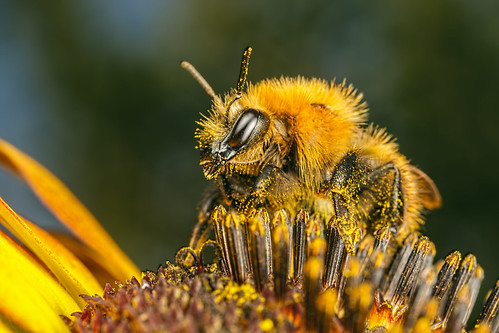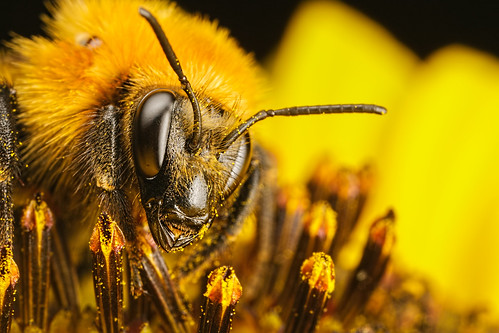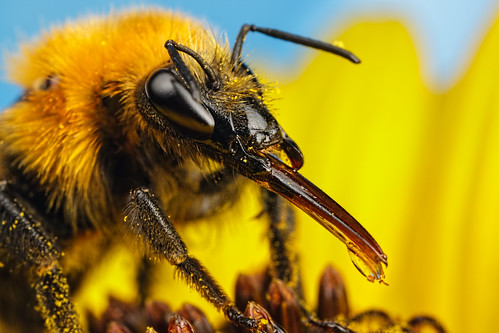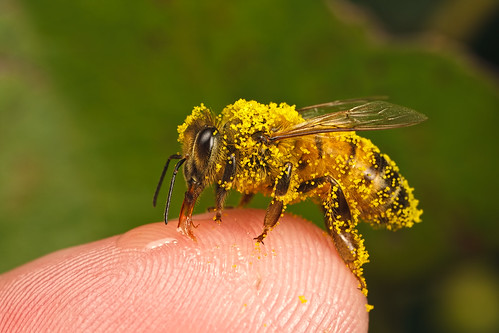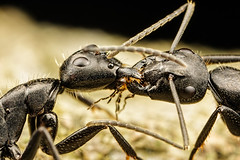The last time I was out at my Mother in law's farm something strange happened. It was late in the evening and I found a bumblebee foraging on a sunflower and it didn't care how close I was getting. As long as I kept my movements slow I could get as close as I wanted, and even managed to grab onto the stem of the sunflower and rotate it a little several times. I probably stood there for a good twenty minutes shooting the critter, taking an occasional break to give my arms a rest (the joys of hand holding about 2.5 kilos in camera gear straight out in front of my body). While photographing the bee my flash batteries started to die, and I accidentally took a few frames without the flash. While chimping through the images on my camera's LCD later I started to delete them and then I realized I could turn the whole situation into a happy accident and explain a few things about mixing light sources. I was attempting to drag the shutter -use a slow shutter speed (in this case 1/30) to expose for the natural light behind the subject, and then use the flash to not only expose for the subject itself but to freeze any motion that might be in the scene. The slow shutter speed shouldn't make any difference with respect to the subject because there just wouldn't be enough natural light to expose it, and I don't care about movement in the background while the shutter is open since it's going to be out of focus anyway. Works really well if the background is well lit and the subject is in heavy shadow. But I was shooting in the late evening and had to be careful because the background light levels were low -exposing for the background would put me dangerously close to exposing for the subject, as you can see in the frame below when the flash didn't fire.
To me there are three things that stand out in that image. There is a specular highlight caused by the sun in the bee's eye. That specular highlight is going to be additive with the one that the flash will create, possibly reducing the detail in that area of the eye. I can also see the color in the bee's "fur" and the sunflower's petals so both those area could be subject to ghosting if there is any movement, and it usually ends up looking like an odd shadow or blur of colors in those areas that are being exposed by the natural light. Fortunately for me the bee wasn't moving, I had the flower's stem in my left hand and the lens resting on that same hand, and I press the shutter on my camera like I'm squeezing the trigger on a gun. Here is the resulting frame with the flash.
I like the angle that I have on the bumblebee and the way it seems to be posing for me, but I don't like the foreground (too distracting). Since the natural light was failing I eventually went to twice life size, brought the shutter to 1/250 to cut out all of the natural light, and just let the background go black due to flash falloff (nothing in the background to reflect the light from the flash back into the camera so it simply becomes black). I could have done the same thing when I was shooting the life size scene above, but if there is a lot of space around the subject I want to see some color in it other than black (and based on feedback so do you). Here's the resulting 2x frame.
Exposing for two light sources sounds tricky, and it can be. Keep in mind that the natural light exposure is going to be effected by changes in ISO, shutter speed, and Fstop. Flash exposure is effected by ISO and Fstop but not the shutter speed as long as the speed of the shutter is not faster than the flash sync speed. When using the flash to freeze motion you want to avoid using high speed sync (HSS) since it pulses the flash to take multiple exposures while the shutter is open and any movement while the flash is pulsing will be recorded.
By now it should be obvious why I've been experimenting with materials to reflect the flash back into the camera so I can cut out the natural light in a scene and just use the flash as a single light source. Like my "blue sky" -a piece of light blue plexiglass with a sheet of glossy photo paper behind it.
Or a nearby grape leaf and a honeybee that's cooperative enough to let me move her in front of it for a shot.
Until next time happy shooting folks :)


